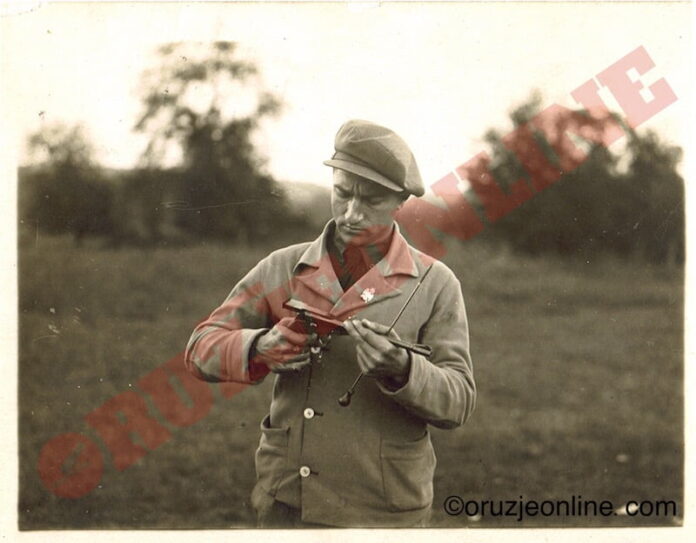Yovanovitch (Jovanovic) system semi-automatic pistol was first described by Dr Joseph Howard Matthews (1881-1970). The University of Wisconsin eventually published the first edition of his two volumes work ”Firearms Identification” in 1962. On page 611 (Volume I) the author says: ”One Yugoslav pistol which is of native origin is the 9 mm. Yovanovitch. L. Yovanovich was an officer-engineer-inventor who designed and developed this pistol, then sold it to theYugoslav Government. It was manufactured by the Vojno Tehnichki Zavod….
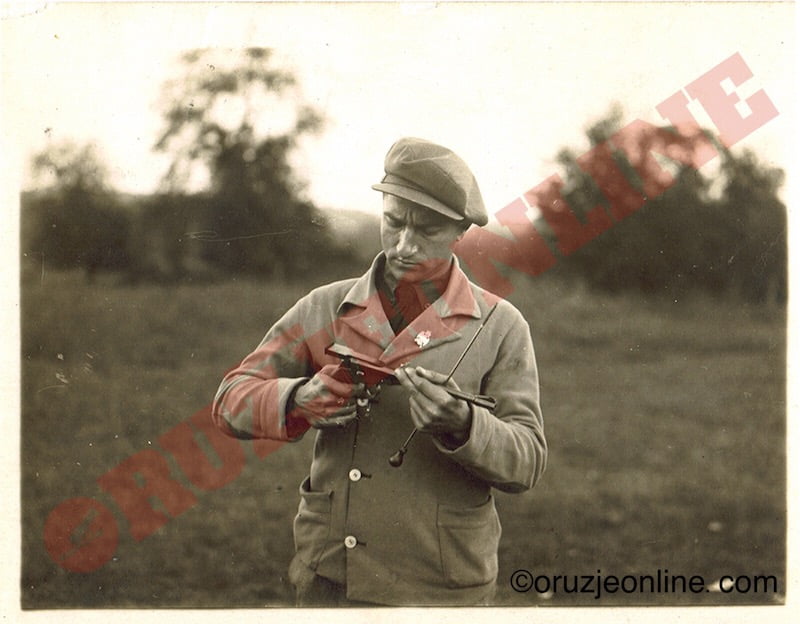
The barrel and bolt are contained in a tapered tubular housing which runs the entire length of the arm. The pistol is disassembled by turning a milled head at the rear of the housing. It has a mechanical thumb safety located in front of the left grip piece-a lever set in a vertical position with the „Safe“ and „Fire“ positions indicated in Serbian. The grips are of plain wood, without serrations or checkering. The inscription on the barrel reads PATENT L. YOVANOVITCH MODEL 1931. There are no proof marks or other markings… It is said that a substantial order for pistols was obtained from Haile Selassie of Ethiopia in1954 and that these were made and delivered. This statement has not been confirmed, but, if true, it is likely that they were the 9 mm. Yovanovitch. A former officer in the Mikhailovitch Army states that pistols of both 7.65 mm. and 6.35 mm. calibers, of the same deisgn, were made. The former were for police and similar use, rather than for military use”.
Since 1962 on all authors as well as the official institutions have accepted the statement without any checking. Consequently, in the current FBI National Crime Information Centre 2000 Operating Manual, (December 2000, p.154), ”Model Yovanovitch, Country – YG” (Yugoslavia) recorded as ”Code YOV”. However, the true story about the weapon is quite different.
Lazar Jovanovic (Yovanovitch) was born in Belgrade 1898 to a prominent Serbian historian and politician Ljubomir Yovanovitch. After WWI, he enrolled in Faculty of Engineering of Ghent University in Belgium. Therefore, he left his studies soon (he has never graduated) returned to Belgrade and dedicated himself to arms construction and shooting sport. Yovanovitch came into contact with the well-known manufacturers of Target Rifles and Pistols – gunsmith & firearm dealer Carl Widmer (C. Widmer Büchsenmacherei und Waffenhandlung) of St. Gallen, Switzerland, and Julius Gottfried Anschütz GmbH & Co. KG., located in the Thuringian city of Zella-Mehlis, Germany. On July the 16th 1932, Yovanovitch designed a single shot .22 target pistol based on a specific bolt rotation system: the bolt is rotated in a helical motion (of rotational motion to forward motion). The constructor filed the specification No.612 at a Yugoslav Patent Office on July 16th, 1932. Finally, Yovanovich was granted Patent Number 10.491 on November 1st, 1933.
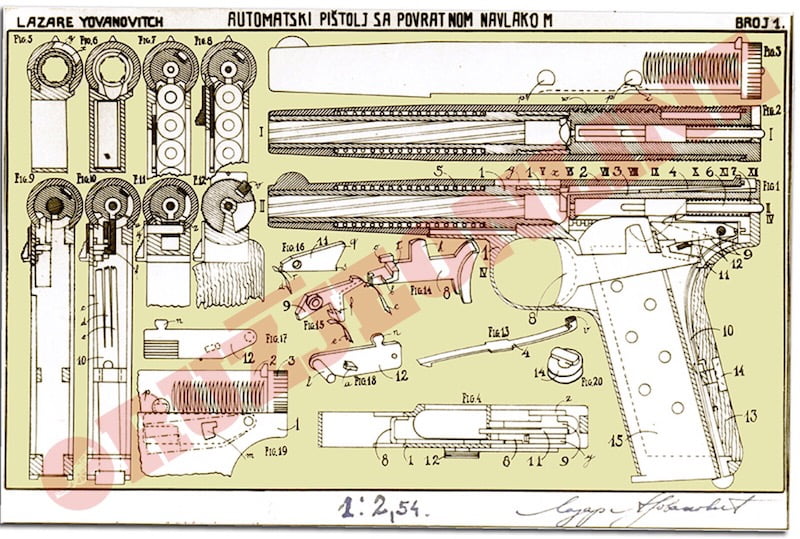
Due to this patent C. Widmer assisted by J. G. Anschütz, started the production of target pistols Model Widmer-L.Y (Lazar Yovanovitch) in 1934. Regrettably, Yovanovitch was inexperienced in business matters and his design was not patented out of Yugoslavia so that J. G. Anschütz soon renamed the pistol as Model ”International” and continued its production without any participation of the Yugoslav constructor.
On the other hand, Yovanovitch was simultaneously working on the construction of semi-automatic military service pistols. The initial version was 22 l.r. & 380.ACP. calibre pistol with under barrel tubular magazine, designed for military competition shooting. However this weapon has never been manufactured.
In 1930, Yovanovitch made only one piece of the first version of the .380 ACP semi-automatic military service pistol to be his personal weapon. Technically, M1930 is a blowback operated semi-automatic pistol. The recoil spring is located around the barrel, the trigger is of single action type and the gun is striker-fired. Pistol featured three safeties – magazine safety (which blocks the firing when magazine is removed), automatic grip safety at the front side of the grip and mounted manual safety at the left side of the gun. The magazine catch is located on the side of the grip, next to trigger guard. The breechblock is locked in the rear of the slide with the cross bolt lock, which secured against falling out by the safety pin with spring. Furthermore, the pistol is with cartridge counter – pointer at the grip and magazine. 8 pointer pin, each with own spring, are built in the wooden grip. The magazine right side is with slot through which glides the follower pointer disc. The follower pointer disc is screwed into the follower left side. As the follower moves up, the disc pushes the pins one by one, and this stubs the hand of the shooter by its point.
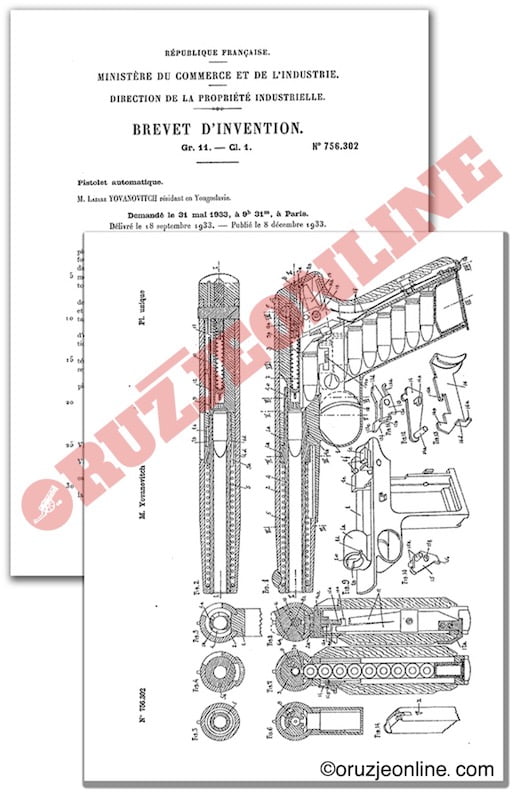
With the .380 ACP M1930 Yovanovitch took part in the 29th IISSF World Championships 1933 in Granada, where the men’s 25 metres Rapid-Fire Pistol was first introduced, but only as a test competition. Shortly before he left for Spain, on March the 8th 1933, the Yugoslavian International Shooting Sport Federation (SSKJ) issued to Yovanovitch the Permit No. 893, required to transport the weapon abroad. The document says that Yovanovitch travels abroad with ”one single-shot target pistol chambered in .22 rim fire, serial No. 449, and one 9 mm Semi-Automatic Pistol of his own design (M1930)”. With the same pistol Yovanovitch took part in XI Olympic Games in Berlin. The men’s 25 metre rapid fire pistol competition (automatic pistols and revolvers of all calibres) was held on August 6, 1936 at the shooting ranges a ”Deutsche Versuchsanstalt für Handfeuerwaffen” e.V. Berlin-Wannsee. After the first series (three series of six shots – every target visible for eight seconds; 53 shooters from 22 nations competed) the 25 marksmen, including Lazar Yovanovich were eliminated, because they did not achieve 18 hits.
Yovanovitch concluded that his personal weapon M1930 was too complicated to become a Military Service Pistol. Regardless. in September 18, 1933. Yovanovich in Paris filed Patent Application and in May 31, 1933, was granted a French. patent No. 756.302 for his pistol M1930 (only without cartridge counter – pointer), which he called ‘’Pistolet Automatique’’.
In order to interest the Yugoslav Military in his weapon, he designed somewhat simpler weapon in 1931. The M1931 was also blowback (unlocked breech) operated semi-automatic pistol. The recoil spring is located around the barrel, the trigger is of single action type and the gun is striker-fired. Pistol featured two safeties – magazine safety (which blocks the firing when magazine is removed) and mounted manual safety at the left side of the frame. Heel magazine release is located at the butt of the pistol grip and is a simple catch.
The extractor on the pistol has a double function being both an extractor and the spring loaded lock for the threaded takedown breechblock at the rear of the slide.
Drawn up the extractor head allows the breechblock to be rotated counter clockwise and then removed from the slide. With the breechblock removed, the separate striker and striker spring can be pulled out to the rear. Pressing the trigger releases the slide and recoil spring, allowing it to run forward off the frame.
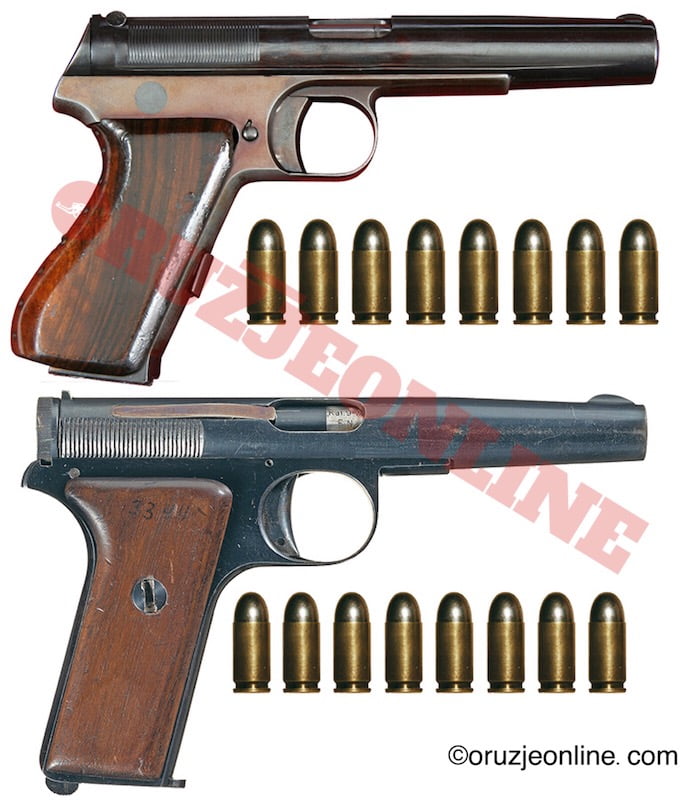
The pistol uses a striker firing mechanism; pressure on the trigger causes the trigger bar to move to the rear and down, where it disengages from the disconnector striker’s nose and frees it to go forward under spring pressure and fire the cartridge. There is a safety catch on the left side of the pistol that prevents the trigger from moving when engaged.
Constructor filed specification No.494 at a Yugoslav Patent Office on July 1st, 1934 and offered his M1931 pistol to the Military-Technical Committee of the Yugoslav Royal Army. In order to provide support of the high court and military circles, Yovanovich made a single piece of the pistol and presented it to the Yugoslav King Aleksandar I Karagеorgevich. The weapon was completely gold plated with the ivory grip panels inserted with golden king’s Cipher (AI). There was Cyrillic inscription engraved on the slide: ”Patent L. Јovanovic / Model 1931”. However, the Patent Office of Belgrade disapproved Yovanovics’ patent, and the Military-Technical Committee showed no interest in the M1931 either. Consequently, this version has never been manufactured by the Military Technical Institute at Kragujevac and never became a Military Service weapon of the Yugoslav Army. Yet, the failure did not discourage Yovanovich. In the same year, that is to say 1934, he designed a toggle-locked, short recoil action weapon for higher-powered cartridges. Having a bad experience with Widmer and Anschütz, this time he engaged another agent in a prominent Swiss Patent Agency ”A. Braun Héritier Eschmann AG”. Patent attorney firm ”A. Braun Braun Héritier Eschmann AG” was established in Basel (Bâle) in 1888 by Amand Ritter, as one of the first patent agencies in Switzerland. In 1898, Amand Braun joined the firm and managed it from 1921 until his death in 1943. On October the 15th Amand Braun provided Yovanovich’s design with Swiss Patent No.180,095. On the base of the patent, Yovanovich designed a toggle-delayed blowback semi-automatic pistol, and on June the 1st 1934 he got the Yugoslav patent No.10,940 for it. Therefore, the Military-Technical Committee of the Yugoslav Royal Army found this version too complicated for the practical use.
When on April the 6th 1941, Germany and Italy attacked the Kingdom of Yugoslavia, Lazar Yovanovitch was enlisted as Petty Officer First Class in the 1st Hydroplane Squadron, The Bay of Kotor. Before leaving for Kotor, he left his M1930 pistol at home in Belgrade. Regrettably, shortly after, Yovanovitch was taken prisoner by the Italians on April the 17th and escorted to the POW Camp P.G. 63 Marinaro Aversa near Arezzo. On signing the armistice with Italy, and before the Germans entered Aversa, he managed to flee from the Camp on September the 13th and reached Switzerland. He settled down in Sainte-Croix in the canton of Vaud, and continued his constructional work. In Switzerland, he patented several target rifles and pistols. However, already in 1951 Yovanovitch moved to Canada and opened a small private arms manufacturing workshop in the 71 St. Elisabeth Street, Longueuil. There, in 1958 he manufactured one more piece of the M1931 pistol. The weapon had usual wooden grip panels, and the left side of the slide bore an impressed inscription: ”Patent L.YOVANOVITCH / MODEL 1931”. Yovanovitch built in the pistol the old barrel taken from the Official Yugoslav Military Sidearm – 9 mm Browning M1910/22 pistol. Accordingly, genuine Belgian manufacturer markings remained on the barrel ”Fabrique Nationale” (F.N.) as well as calibre mark (Kal. 9 m/m).
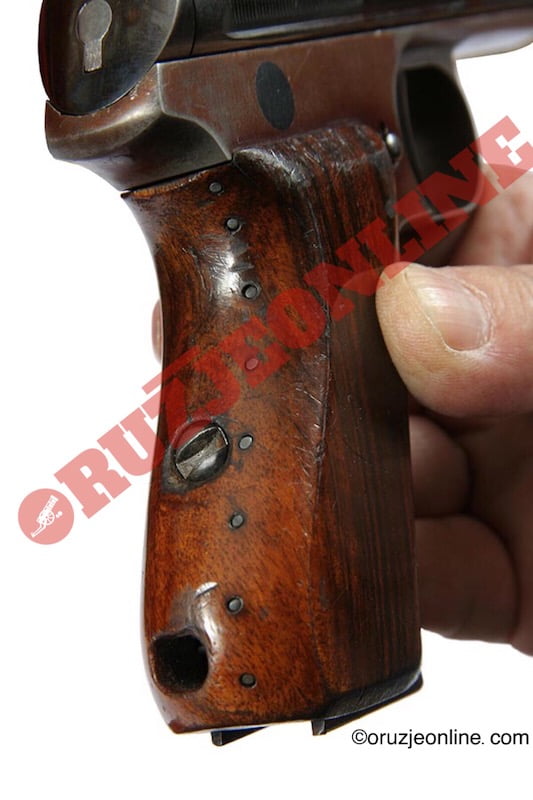
For that pistol on February the 27th 1959 the Chief and Director-general of Québec Provincial Police, Hilarie Beauregard issued him Firearm Permit No.84,159. ”This permit authorizes Mr Lazar Yovanovitch to have a pistol elsewhere than in his dwelling-house or place of business for the Protection in the interest of his business – Demonstration purpose and Repairs Service – Target practice”.
In fact, the Canadian government realises the Act to amend the Criminal Code of 30 June 1951 inadvertently banned a substantial number of ‘sporting’ rifles and shotguns, and 26. June 1954 adopted a new Act respecting the Criminal Law. The Form 76 series of permits disappears, replaced by the Form 42- Firearm Permit. While the Form 76 specified that a handgun can be carried ”. . . for the protection of life or property, or for target practice”, the Form 42 now states the purpose for which the firearm is required (target shooting, self or property protection), and authorises it to be possessed ”. . . Since the Code does not specify how the handgun is to be transported and because it is not expressly prohibited, the concealed carry of firearms by authorised citizens is still permitted. It remains perfectly legal for authorised permit holders to carry their handgun concealed upon the person”.
Because of a tough financial situation, Yovanovitch was compelled to sell own and the only one M1931 pistol in USA in 1960. It was the very piece seen by Dr Joseph Howard Matthews on the base of which he created a myth about the Yugoslav weapons ”manufactured by the Voino Tekhnichki Zavod”. Also, on the grips is a crudely hand-written 4-digit number (3344), which Mathews declared as a serial number.
Yovanovitch returned to Belgrade on September the 7th 1974 and died soon on January 28th 1975.
The M1931 pistol remained in USA, published by Mathews in late 20th century and later it was sold on an auction in Switzerland and later, in 1977, in Austria (Linz).
Gold plated M1931 pistol was given to the Military Museum of Belgrade after the assassination on King Aleksandar in 1934. Sadly, in 1944 this rare item was stolen from the Museum.
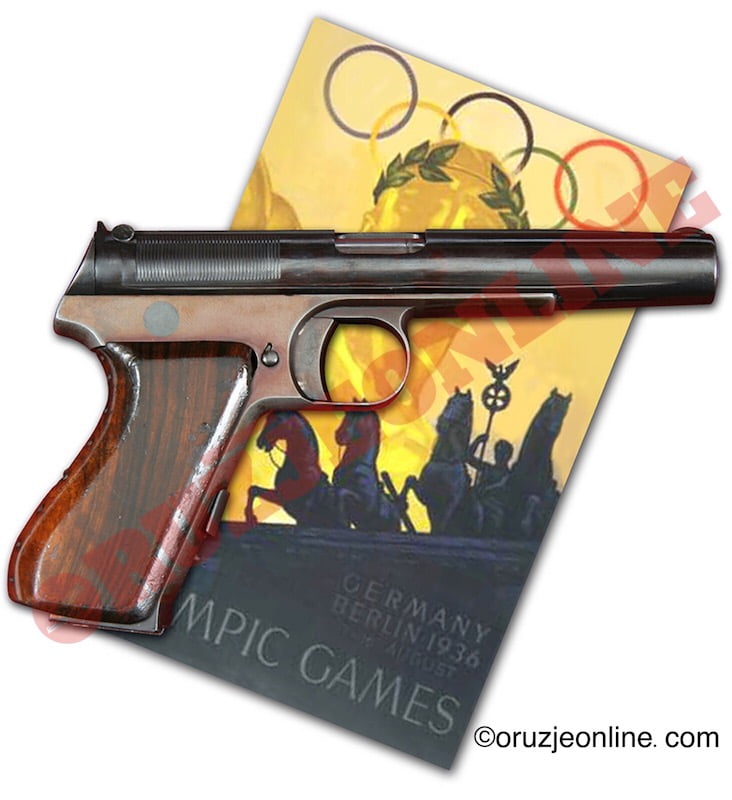
TECHNICAL DATA:
M1930 Pistol
- Designed: 1930
- Designer: Lazar Yovanovitch
- Manufacturer: L. Yovanotvitch in Military-Technical Institute Kragujevac
- Number built: 1
- Type: Semi-automatic pistol
- Action: Blowback
- Cartridge: 9×17 mm Browning .380ACP
- Total length: 8” (203 mm)
- Barrel length:: 4 ¼” mm (108 mm)
- Rifling: six grooves with the right-hand twist of one turn in 9.4” (240 mm).
- Land Width: .045” (1 mm)
- Bore Diameter: .3504” (8.9 mm)
- Groove diameter: .358” (9.1 mm)
- Feed system: 8-round, detachable box magazine
- Height: 4 3/5” (117 mm)
- Weight unloaded: 20.8 oz (590 g)
- Sights: Front blade, rear notch
M1931 Pistol
- Designed: 1931
- Designer: Lazar Yovanovitch
- Manufacturer: L. Yovanotvitch in Military-Technical Institute Kragujevac and in his own workshop in Longueuil, Canada.
- Number built: 2
- Type: Semi-automatic pistol
- Action: Blowback
- Cartridge: 9×17 mm Browning .380ACP
- Total length: 7 ¼” (184 mm)
- Barrel length: 4 ¼” mm (108 mm)
- Rifling: six grooves with the right-hand twist of one turn in 9.4” (240 mm).
- Land Width: .045” (1 mm)
- Bore Diameter: .3504” (8.9 mm)
- Groove diameter: .358” (9.1 mm)
- Feed system: 8-round, detachable box magazine
- Height: 4 5/8” (117 mm)
- Weight unloaded: 19.3 oz (520 g)
- Sights: Front blade, rear notch
